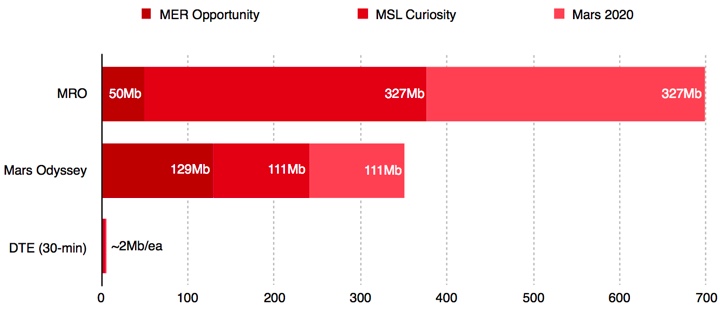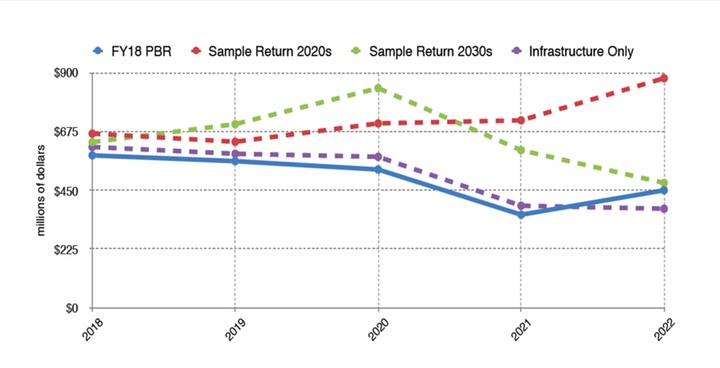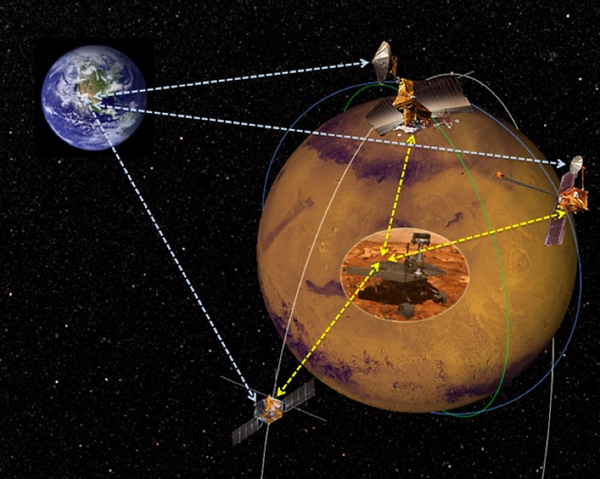The future (or lack thereof) of NASA’s Mars Exploration Programby Jason Callahan and Casey Dreier
|
| Budget cuts to the Mars Exploration Program in 2009 and 2013 upset the planned mission cadence necessary for progress on the scientific goals outlined in NASA’s strategic plans for the program. |
The MEP maintains its own technology development program, provides research funding for Mars scientists, supports placement of US scientific instrumentation on Mars missions led by international partners, conducts operations for all existing NASA Mars spacecraft, and engages in strategic planning for future missions, all while providing continuity of purpose and technological capability for the scientific exploration of Mars.
In addition, the MEP serves to inform planning for future human exploration. NASA’s robotic missions contribute to a future human mission to Mars by providing data on topics such as planetary protection issues; surface and in-transit radiation measurements; landing site characterization and mapping, entry, descent, and landing tests; dust conditions; and potential in-situ resource utilization (ISRU) identification and validation.
However, budget cuts to the Mars Exploration Program in 2009 and 2013 upset the planned mission cadence necessary for progress on the scientific goals outlined in NASA’s strategic plans for the program, potentially endangering the viability of the MEP.2
Telecommunications, Mars 2020, and Sample Return
NASA maintains a satellite communications network around Mars, the only other planet beyond Earth with this capability. NASA’s orbiting science spacecraft serve as data relay satellites for ground missions by taking time off from observations to communicate with landed assets and send their data back to Earth.
Designing surface robots that depend on orbital assets provides several advantages to surface missions. Orbiting spacecraft have larger and more powerful communications antennae and can transmit data back to Earth at far higher data rates. Surface missions can send large amounts of data to an orbiting spacecraft very quickly as it passes overhead, freeing time for surface operations and scientific exploration. It also allows engineers to design small, low-power antennas for direct-to-Earth (DTE) communications on surface missions. Limiting the mass and power requirements of surface craft provides significant cost savings due to lower launch vehicle lift requirements; reduced mass requirements for entry, descent, and landing; and increased mobility. It is only due to the presence of reliable data relay satellites around Mars that NASA is able to use scientific instruments that generate significant amounts of data while maintaining the mobility of its rovers.
Mars Odyssey and the Mars Reconnaissance Orbiter (MRO) act as the primary relay satellites for the Opportunity and Curiosity rovers, respectively. Each orbiter passes over each rover twice per sol (Martian day). They also provide critical communications coverage during entry, descent, and landing sequences for NASA, European Space Agency (ESA), and future SpaceX missions.
Maintaining this telecommunications infrastructure is an ongoing challenge for the Mars Exploration Program. Odyssey and MRO have been in deep space for 16 and 12 years, respectively. And while both are generally healthy, they are showing signs of age. A hardware failure in 2012 forced Odyssey to switch to a backup mechanism used to stabilize the spacecraft.3 Should its backup fail, the spacecraft would exhaust its remaining fuel supplies within a year. MRO is in better shape, but has aging batteries and gimbals and is being carefully managed to allow operations to continue through 2023, barring any unexpected issues.
NASA has invested in several backup options, though they are suboptimal replacements for its two primary relay satellites. One backup is the Mars Atmosphere and Volatile EvolutioN (MAVEN) spacecraft, which has specialized hardware enabling it to serve as a data relay satellite. However, its science orbit is elongated and the spacecraft passes over the rovers only once per day, precessing in time. MAVEN could be repositioned into a more circular orbit, should it be needed, though it would greatly impact the science return of this mission. But even so, the precessing orbit would still make planning surface operations difficult.
| The scientific instrument suite on Mars 2020 will generate more data than any landed mission in history, and it will require a reliable data relay system to ensure the primary mission goals are met. |
The European Space Agency (ESA) maintains two orbiters at Mars as well, and both can serve as backup relay satellites. Mars Express, launched in 2004, demonstrated data relay capability for NASA’s surface missions, albeit with a slower data rate than Odyssey or MRO. The Trace Gas Orbiter (TGO) arrived at Mars in the fall of 2016 and contains a NASA-provided antenna system, allowing it to communicate at high speeds with surface assets. Though TGO has the highest relay bandwidth capacity of any orbiter yet sent to Mars, both it and Mars Express are in orbits that precess through local time. Also, the top priority for TGO is to support ESA’s upcoming ExoMars rover mission, launching in 2020.
NASA is currently in the implementation phase of the Mars 2020 rover project, a follow-up to the Curiosity rover budgeted at $2.4 billion and planned to launch in July 2020.4 Though there is important in-situ science planned for Mars 2020, the rover is also designed to drill and cache stores of Martian surface samples for an as-yet-unapproved sample return campaign that will greatly aid the goal of seeking signs of ancient or extant life.
The Mars 2020 rover will launch in July 2020 and land in early 2021. Its prime mission is approximately three Earth years, carrying it into 2024, and there is reasonable expectation for an extended mission beyond that. At that point, MRO will be nearly 20 years old and likely the only data relay satellite available that could support regular rover operations. Even if MRO continues through the prime mission of Mars 2020, it is unlikely to last through the remainder of the decade of the 2020s, leaving a potential gap in NASA’s telecommunications infrastructure for future surface missions at Mars, including potential extended missions for Mars 2020. Curiosity—Mars 2020’s sister rover—also had a two-year primary mission and is now in its fifth year of surface operations.
Additionally, the scientific instrument suite on Mars 2020 will generate more data than any landed mission in history,5 and it will require a reliable data relay system to ensure the primary mission goals are met. While Mars 2020 does have the means to communicate directly with Earth, depending on a DTE link reduces data speed from megabits (millions of bits) per second to roughly one kilobit (thousands of bits) per second (see Figure 1). This data rate difference of three orders of magnitude has been likened to switching from high-speed broadband to a dialup modem for Internet access.6 The lack of a functioning data relay satellite would threaten the mission success of NASA’s flagship Mars rover and potential future landed missions in the 2020s.
 Figure 1. Comparing estimated daily data return (in megabits) from Mars orbiters vs. direct-to-Earth (DTE) communications. Note that the minimum daily data return for mission success of MSL Curiosity is 250Mb/sol. Mars 2020 rates will be similar but likely higher due to the large amount of data generated by its instrument suite. Source for MRO and Odyssey data: Edwards, et. al. “Replenishing the Mars Relay Network,” 2014 IEEE Aerospace Conference, March 2014. The DTE rates are rough estimates made for comparison purposes only. Numbers assume an average data rate of 1.1 kb/s per sol for each rover. Ground assets are able to communicate their data to the orbiters in brief bursts for about 15 minutes twice per sol. For a direct comparison we provide a DTE communications estimate using 30 minutes of transmission time. |
The future of the Mars Exploration Program
In the 2011 Planetary Science Decadal Survey, titled “Visions and Voyages,” the report committee proposed three crosscutting themes consisting of ten key scientific questions in planetary science, and three themes consisting of seven key questions directly related to Mars science.7 The committee recommended a single Mars Exploration Program mission that would address six of the ten cross-cutting key questions and all seven of the Mars science key questions: Mars Sample Return.
In response, NASA began planning for the Mars 2020 mission in 2012 based largely on technology developed for the Mars Science Laboratory project and capable of caching samples for recovery by a later mission.8 Mars 2020 is the only Mars mission approved in the context of the current decadal survey and the only mission in development by the MEP.
But from the moment Mars 2020 lands on the Martian surface, a clock will be ticking. The Mars 2020 rover uses a radioisotope power source—similar to the one on the Curiosity rover—that is capable of providing the rover with heat and electricity for at least six years, well beyond the three-year primary surface operations currently planned. At that point, the only orbiting spacecraft at Mars expected to be operational after 2020 is MRO, which will be 20 years into a five-year mission in 2023. Without a new telecommunications and high-resolution imager at Mars to replace the capability of MRO, the Mars 2020 rover would be forced to operate with significantly restricted communications, drastically impacting the science return that will be received after significant taxpayer investment.
| NASA, the White House, and Congress must make decisions within the next fiscal year to ensure communications relay capability supporting ground operations of the 2020 rover and sample retrieval. |
Further, there is crucial advantage to having a telecommunications and high-resolution imaging orbiter and a Mars Ascent Vehicle (MAV) mission operational at the same time. It certainly is not possible, for example, to fly the orbiter first and have its operations end before the MAV mission occurs. So, in order to collect and return useful samples, NASA has a limited number of Mars launch opportunities—which occur only every 26 months—after Mars 2020 to send a telecommunications mission and a mission to retrieve the samples so that the two missions overlap sufficiently to realize the required capability dependencies.
Another consideration is that the sample containers on Mars 2020 have a finite lifetime of scientific viability. Current design specifications enable the preservation of scientifically valid samples for 20 years, though it is possible they could safely contain samples for a longer period.9
In “Visions and Voyages,” the committee evaluated three mission concepts for completing the goal of Mars sample return; a mission called MAX-C that eventually evolved into the Mars 2020 mission, a Mars Sample Return Lander with Mars Ascent Vehicle (MAV), and a Mars Sample Return Orbiter with Earth Entry Vehicle (EEV). The MAV lander would be equipped with a “fetch rover” to collect the samples cached by the Mars 2020 mission and place them in a rocket that would launch them to Mars orbit. The orbiter would then retrieve the samples and deliver them back to Earth. An independent cost review found that the lander mission, including the first launch from the surface of Mars, would cost approximately $4 billion, while the orbiter estimate was roughly $2.1 billion. Further studies have indicated that the missions could be accomplished for less,10 though NASA has not begun formulation of either mission.
With only one mission in development, an average mission development time of approximately five years, and a launch window that opens every 26 months, NASA, the White House, and Congress must make decisions within the next fiscal year to ensure communications relay capability supporting ground operations of the 2020 rover and sample retrieval.
NASA is studying a number of concepts for its next orbiter, but it has not yet committed to flying a mission. Because of the timing of the Mars launch opportunities and the development time for spacecraft, NASA would have to commit to a new mission in its fiscal year (FY) 2018 budget in order to realistically be ready for the 2022 Mars launch opportunity. And even then, the orbiter would arrive at Mars at the end of the prime mission of the Mars 2020 rover.
Notably, no new start for an orbiter was included in the FY 2018 budget request.
Recommendations and pathways forward
In light of the current circumstances regarding the Mars Exploration Program, The Planetary Society makes three core recommendations:
- NASA should immediately commit to a Mars telecommunications and high-resolution imaging orbiter to replace rapidly aging assets currently at Mars.
- NASA should enter formulation for a sample retrieval rover and Mars Ascent Vehicle mission to continue the overall Mars Sample Return campaign.
- NASA should formulate a follow-on strategy to the Robotic Mars Exploration Strategy, 2007–2016 document.
Recommendations 1 and 2 will ensure that NASA meets the highest priority decadal survey large-mission goal of returning samples from Mars. Recommendation 3 will help NASA to continue—and to capitalize on—the enormous success of the Mars Exploration Program by ensuring its Mars missions are strategically aligned to answer the most pressing science questions.
| It seems clear from this analysis that NASA is barely keeping the Mars Exploration Program on life support. |
In the “Mars in Retrograde” white paper, The Planetary Society examined three options for implementing recommendations 1 and 2. The first option is the most ambitious and places NASA on a firm path toward successful return of Martian samples in the 2020s by combining the Mars-orbit-to-Earth portion of the sample return architecture with the telecommunications and high-resolution imaging mission. However, the necessary inclusion of new technology development for the orbiter could result in a later launch date, placing a continuous high-speed telecommunications capability to and from the Martian surface in jeopardy for a time.
The second option also keeps NASA on a path toward sample return, but on a slower trajectory (in the 2030s) and with fewer science returns, though it does result in continuous high-speed surface communications. The third option involves essentially flying a radio to orbit Mars sometime in the 2020s. This is the bare minimum effort necessary to keep a Mars sample return campaign active and retain the viability of the Mars Exploration Program, though this option risks loss of continuous high-speed telecommunications at Mars.
The Planetary Society analyzed cost estimates of the three options and compared them to NASA’s projected budget for planetary science in the FY 2018 President’s Budget Request (see Figure 2).
 Figure 2. Comparing the annual Mars Exploration Program budget necessary to accommodate the Mars Exploration Program options as outlined in The Planetary Society’s Mars in Retrograde white paper to the actual notional budget for the program as proposed within the White House’s FY 2018 budget request. Current budget projections most closely match the “infrastructure and deferred sample return” option. |
It seems clear from this analysis that NASA is barely keeping the Mars Exploration Program on life support. With no plans for future missions within the MEP and a bleak budget posture over the next five years The Planetary Society is actively engaging in outreach to stakeholders to draw awareness to this situation and provide options for a healthier, robust program of exploration at Mars. Congress can take decisive action in this budget cycle to provide Phase A funding for a new orbiter. $70 million now provides a fighting chance for a 2022 mission. We also strongly urge Congress to provide funding to mature critical technologies needed for the Mars Ascent Vehicle in order to mitigate risk for a future sample return mission.
Absent congressional action, NASA will miss the 2022 launch date. As international interest heats up for Mars exploration, the United States may find itself in an unexpectedly weak position, as its 20-year commitment to Mars exploration winds down though inaction and neglect.
Endnnotes
- An additional robotic mission to Mars, InSight, will launch in 2018, but as part of NASA’s Discovery program. InSight is a stationary lander that will provide geophysical measurements relating to the interior of Mars.
- Mars Advanced Planning Group, Robotic Mars Exploration Strategy, 2007–2016. Pasadena, CA: Jet Propulsion Laboratory, 2006. JPL 400-1276.
- Orbiter Out of Precautionary ‘Safe Mode’. NASA press release. June 12, 2012.
- NASA Office of the Inspector General. NASA’s Mars 2020 Project. January 30, 2017.
- Edwards et. al. Replenishing the Mars Relay Network, IEEE Aerospace Conference, March 2014. DOI: 10.1109/AERO.2014.6836354.
- Email with Dr. Chad Edwards, JPL. April 2017.
- Committee on the Planetary Science Decadal Survey, Vision and Voyages for Planetary Science in the Decades 2013-2022. Pp. 19, 137-174.
- The decadal committee said that the MAX-C Mars rover, the proposed U.S. part of a joint program with the European Space Agency’s ExoMars program, would serve as the first of three missions to return samples from the planet’s surface. The committee also stated that the U.S. contribution to the mission should be reduced from an estimated $3.5 billion to less than $2.5 billion. NASA withdrew from the joint program with ESA in 2011, declining to launch a Trace Gas Orbiter with U. S. instruments or a NASA rover in tandem with the ExoMars rover.
- According to the Mars 2020 project, the samples are “built to last 20 years but with no known failure mechanism known for longer durations,” though the impact of the scientific integrity of the samples beyond that period is unknown. Email correspondence with Mars 2020 engineer Yulia Goreva, April 12, 2017.
- Jim Watzin, presentation to the Committee on Astrobiology and Planetary Science of the Space Studies Board, Space Science Week 2017, Washington, D.C., March 28, 2017.
